Last updated on January 13, 2023
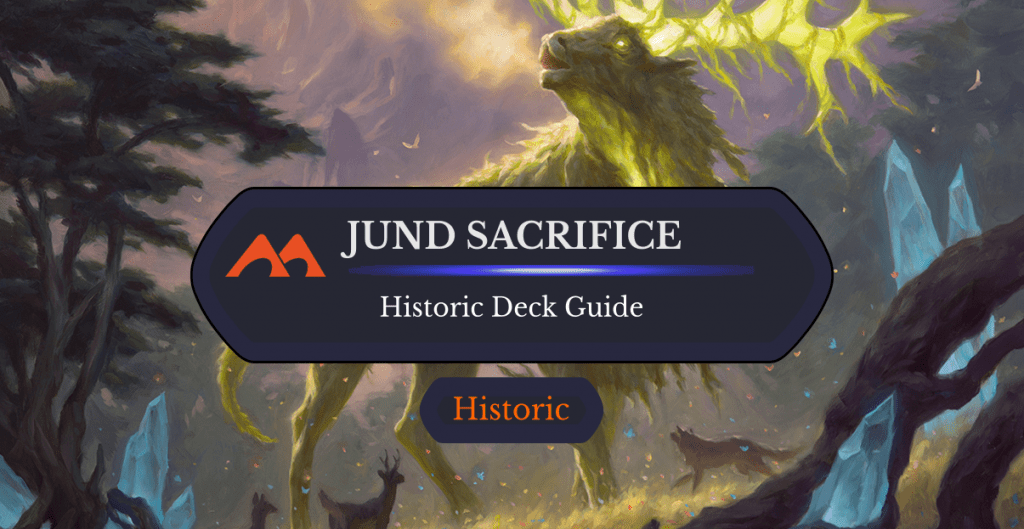
Jegantha, the Wellspring | Illustration by Chris Rahn
Deck/guide update for STX meta by David
Today, I’ll be diving into the world of Jund Sacrifice, a relatively top tier deck in the Historic format. While the deck shines the most in BO1, it has a strong presence in BO3 with a stable 59% win rate.
As metagames shift, Jund remains one of the most flexible decks around with the ability to change into an aggro or a control build depending on what other decks are dominant. Given that it the build runs three colors, there's a vast pool of card options to choose from regardless of what you're up against.
This deck takes a bit of setting up, but you’ll easily overwhelm your opponent once all the key pieces are in place. If you were a fan of Rakdos Sacrifice, this deck plays similarly.
With all that said, let’s jump in!
The Deck
Companion (1)
Creature (18)
Cauldron Familiar x4
Gilded Goose x4
Woe Strider x2
Mayhem Devil x4
Korvold, Fae-Cursed King x4
Instant (0)
Instant (4)
Fatal Push x3
Kolaghan's Command
Sorcery (2)
Enchantment (7)
Trail of Crumbs x4
Binding the Old Gods x3
Artifact (4)
Witch's Oven x4
Land (25)
Blightstep Pathway x4
Blood Crypt
Cragcrown Pathway x4
Darkbore Pathway x4
Fabled Passage x2
Forest
Mountain
Overgrown Tomb x4
Phyrexian Tower
Stomping Ground x2
Swamp
Sideboard (13)
Angrath, the Flame-Chained
Klothys, God of Destiny
Reclamation Sage
Thoughtseize x4
Noxious Grasp x2
Fry x2
Kolaghan's Command
Soul-Guide Lantern
The Strategy
Jund Sacrifice’s tactic is simple: set up your sacrifice engines and then benefit from them by having creatures like Mayhem Devil on the field that continuously bombard your opponent with damage. The Devil can even be used to remove your opponent’s creatures.
While that’s the primary plan, the deck has more depth than that. With the introduction of new Standard and supplementary sets, Jund Sacrifice gained more powerful tools to compete against the main archetypes currently dominating the format. Still, before talking about those, let’s break down its core.
Sacrifice Engine
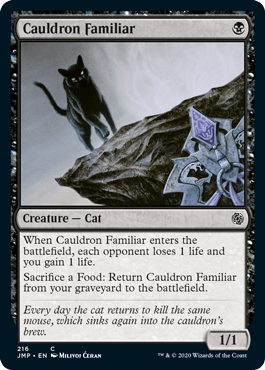
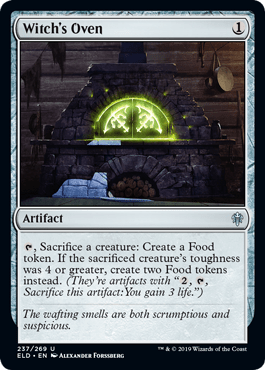
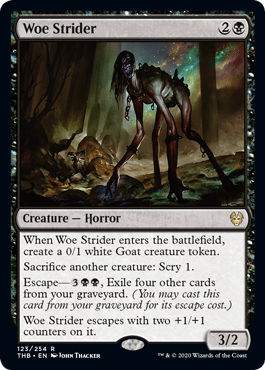
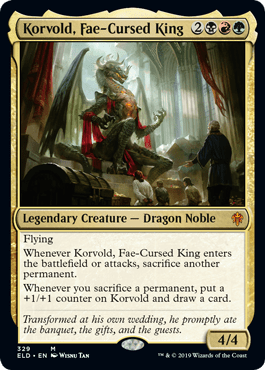
To use our other cards, we need to sacrifice a lot. To do this, we use the infamous Cauldron Familiar and Witch's Oven combo that lets you continuously sacrifice the cat and generate a Food token, which you then sacrifice to bring back the cat. This combo is likely our most important one in the deck.
Second, we have Woe Strider that lets us sacrifice any creature on the field, including the 0/1 token it generates, to scry 1.
Last, we need to go wide to compete with other decks in the meta. That’s why the final sacrifice outlet, Korvold, Fae-Cursed King, fits perfectly in the deck. It has very cool synergies with all your other cards, plus it gives you the cards you need to survive in longer games.
Value Engine
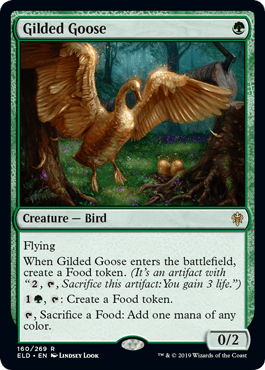
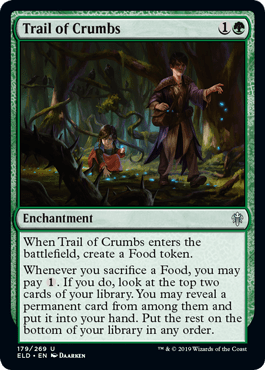
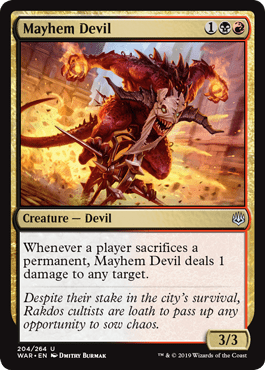

As I already mentioned, this deck relies on the Cauldron Familiar / Witch's Oven combo as its main win condition, but it gains more by transitioning into a control version with a Food subtheme with cards like Gilded Goose and Trail of Crumbs. These synergize very well with Cauldron Familiar, particularly with a couple Trails in play along with some Familiar activations to quickly refill your hand.
Mayhem Devil is insane. It deals one damage to any target every time a permanent is sacrificed. Even your Fabled Passage will trigger this, as well as the Food tokens you sacrifice for Cauldron Familiar.
Finally, Claim the Firstborn goes great with our sacrifice theme to get rid of threats that don’t die to regular removals, like those run by Auras decks.
Utility Cards

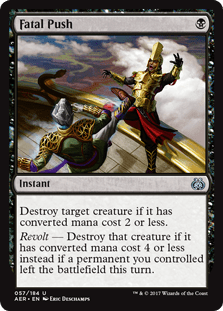
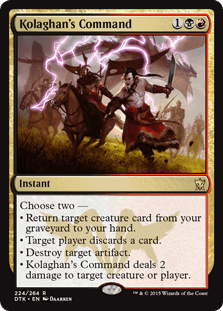
Since we're transitioning from an aggro build into a control version of the deck, Binding the Old Gods works great as unconditional removal. Its other modes help ramp and give deathtouch to our Mayhem Devil as it can one-shot any creature with a sacrifice trigger. It also sacrifices itself on its final mode so it can trigger either Korvold, Fae-Cursed King or the Devil.
Speaking of removal, Fatal Push and Kolaghan's Command complete the package to avoid falling back against aggro strategies. The latter can bring back our key creatures from the dead to assemble or sacrifice value synergies again.
The Win Condition
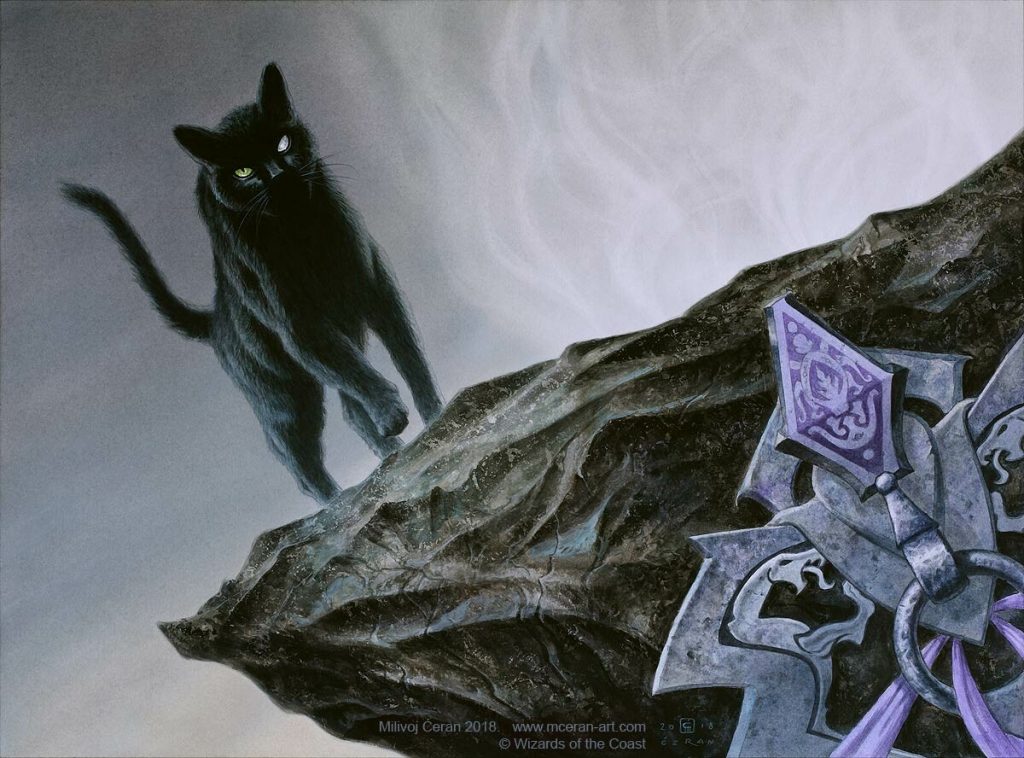
Cauldron Familiar | Illustration by Milivoj Ceran
You win is by combining all these strategies and setting several up. For example, getting a couple of Mayhem Devils or the Cauldron Familiar / Witch's Oven combos set up. Each time you sacrifice a creature, you get to deal multiple damage at once.
A cat-oven combo can help you deal three damage in combination with Mayhem Devil dealing one damage each time you sacrifice the cat or Food and then another damage when Cauldron Familiar enters the battlefield.
All these 1-damage pings may seem low, but they can quickly snowball out of control when you have multiple on the board, allowing for entirely unexpected wins dealing large amounts of damage in a single turn. Because many of our combos can be set up during your opponent's end step, you should wait as long as you can.
Either load the graveyard with your Familiars or cast Korvold, Fae-Cursed King. Your opponent may end up in a position where they can't do anything about you getting everything set up at once.
Alongside all these strategies, you want to attack with your creatures whenever possible. Thanks to our combo cards, we tend to keep the enemy board clear of creatures with various damage effects and forced sacrifices.
Mulligan Rules
- Have a sacrifice combo, like Cauldron Familiar plus Witch's Oven.
- Have three lands, preferably with the ability to cast all three colors.
- Have one of the value engine cards, either Mayhem Devil or Trail of Crumbs.
Sideboard Guide
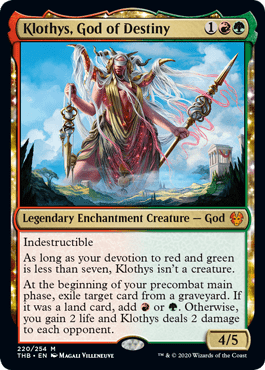


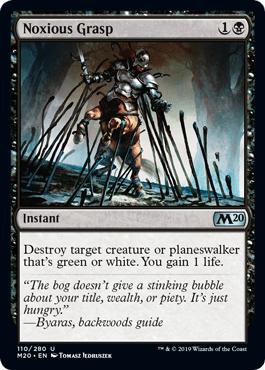
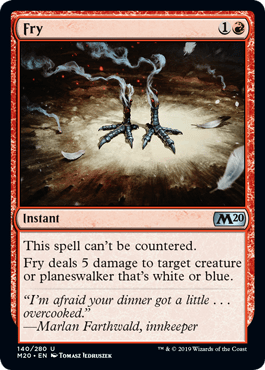

The sideboard has a mix of common options. We have Klothys, God of Destiny to deal with graveyard decks that run things like titans or graveyard recursion. Reclamation Sage is our targeted artifact and enchantment removal. This card is useful against colorless decks or decks that use The Great Henge.
Thoughtseize against control decks or decks that run a lot of removal in general. Noxious Grasp and Fry can deal with creatures or planeswalkers, and these additions are mainly because of the rise in popularity of decks like Jeskai Control and Izzet Phoenix.
Finally, Angrath, the Flame-Chained is very good in control matchups and it be backbreaking against decks that don’t run any planeswalker removal.
Tips and Tricks
My tip is to keep Fabled Passage in your hand as long as possible. The sacrifice ability on this land is fantastic in combination with Mayhem Devil, allowing you to deal one damage to any target by sacrificing it.
Also, always calculate how many things you can sacrifice in one turn. Sometimes this will mean you have lethal on the board with all the triggers alone. Using Witch's Oven or bringing back a Woe Strider to sacrifice everything on your side of the board is great.
You can keep priority when you have multiple Food tokens and just one Cauldron Familiar in the graveyard, sacrifice all your Food, and trigger either your Mayhem Devil or Trail of Crumbs effects with just one graveyard interaction.
With a Cauldron Familiar in the graveyard and keeping priority with Korvold, Fae-Cursed King on the stack, you can get a card from the Familiar/Oven interaction and sacrifice your Familiar so you won’t lose any of the other permanents on the battlefield. Last but not least, the deck runs Jegantha as a companion which can be either a decent blocker or a finisher depending on the situation.
Honorable Mentions

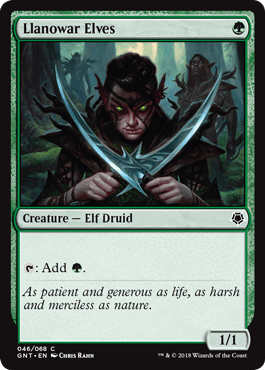

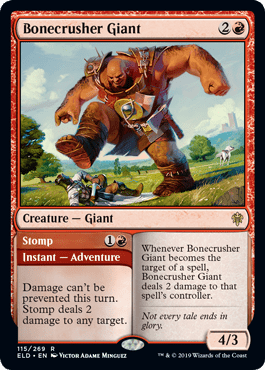

Bolas's Citadel is an excellent card that fits perfectly into this deck. Unfortunately, because of its steep casting cost and the fact we don’t run 1-mana ramp like Llanowar Elves (honorary mention #2), I’ve opted to not run this card in the list. There are metagames where mana dorks can shine, but I believe the current one isn't it.
Scavenging Ooze is a great graveyard hate card, but it may be a bit too ambitious to add in since we’re running a 3-color deck.
Bonecrusher Giant got cut from this list, but maybe wrongfully so. Having the Stomp ability attached to a cast-able body is very good. Feel free to toy around with it.
And finally, there's Vraska, Golgari Queen. This card might actually be excellent in the mainboard. It would add yet another sacrifice engine but can also double-up as removal and card draw. Maybe adding one of these is something you'd like to try.
Wrap Up

Klothys, God of Destiny | Illustration by Magali Villeneuve
This was a concise and to-the-point deck tech. I hope you like these shorter pieces! if so, let me know in the comments below.
Jund Sacrifice is mechanically very satisfying and straightforward but allows for a lot of decision making and calculating how you want to sacrifice your permanents to maximize damage. The deck lacks hard removal, which can be unforgiving at times, but it’s hard to fit those in with all the tight engines. While we want to sacrifice many things, consistency is not one of those, after all.
As always, our Discord is a great place for some longer discussions if that’s your thing. If you're an MTG Arena player, you should check out Arena Tutor. It's like the user-friendly addition that MTGA never had!
Follow Draftsim for awesome articles and set updates: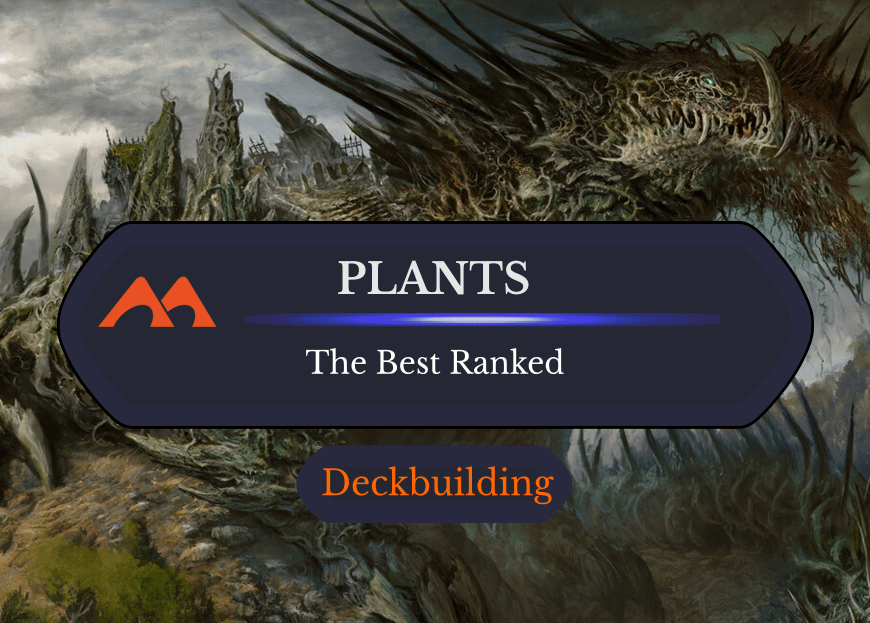
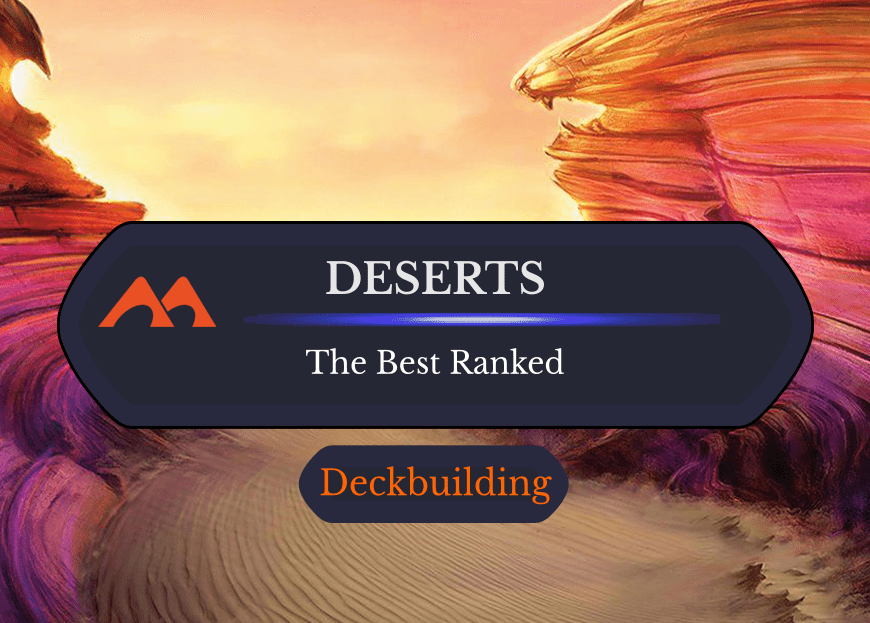
Add Comment